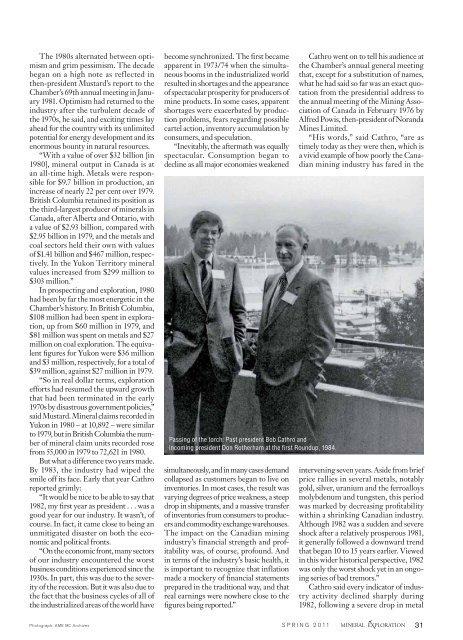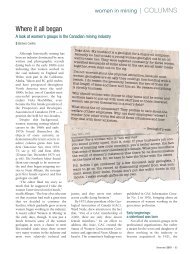Spring 2011 - The Association for Mineral Exploration British Columbia
Spring 2011 - The Association for Mineral Exploration British Columbia
Spring 2011 - The Association for Mineral Exploration British Columbia
You also want an ePaper? Increase the reach of your titles
YUMPU automatically turns print PDFs into web optimized ePapers that Google loves.
<strong>The</strong> 1980s alternated between optimism<br />
and grim pessimism. <strong>The</strong> decade<br />
began on a high note as reflected in<br />
then-president Mustard’s report to the<br />
Chamber’s 69th annual meeting in January<br />
1981. Optimism had returned to the<br />
industry after the turbulent decade of<br />
the 1970s, he said, and exciting times lay<br />
ahead <strong>for</strong> the country with its unlimited<br />
potential <strong>for</strong> energy development and its<br />
enormous bounty in natural resources.<br />
“With a value of over $32 billion [in<br />
1980], mineral output in Canada is at<br />
an all-time high. Metals were responsible<br />
<strong>for</strong> $9.7 billion in production, an<br />
increase of nearly 22 per cent over 1979.<br />
<strong>British</strong> <strong>Columbia</strong> retained its position as<br />
the third-largest producer of minerals in<br />
Canada, after Alberta and Ontario, with<br />
a value of $2.93 billion, compared with<br />
$2.95 billion in 1979, and the metals and<br />
coal sectors held their own with values<br />
of $1.41 billion and $467 million, respectively.<br />
In the Yukon Territory mineral<br />
values increased from $299 million to<br />
$303 million.”<br />
In prospecting and exploration, 1980<br />
had been by far the most energetic in the<br />
Chamber’s history. In <strong>British</strong> <strong>Columbia</strong>,<br />
$108 million had been spent in exploration,<br />
up from $60 million in 1979, and<br />
$81 million was spent on metals and $27<br />
million on coal exploration. <strong>The</strong> equivalent<br />
figures <strong>for</strong> Yukon were $36 million<br />
and $3 million, respectively, <strong>for</strong> a total of<br />
$39 million, against $27 million in 1979.<br />
“So in real dollar terms, exploration<br />
ef<strong>for</strong>ts had resumed the upward growth<br />
that had been terminated in the early<br />
1970s by disastrous government policies,”<br />
said Mustard. <strong>Mineral</strong> claims recorded in<br />
Yukon in 1980 – at 10,892 – were similar<br />
to 1979, but in <strong>British</strong> <strong>Columbia</strong> the number<br />
of mineral claim units recorded rose<br />
from 55,000 in 1979 to 72,621 in 1980.<br />
But what a difference two years made.<br />
By 1983, the industry had wiped the<br />
smile off its face. Early that year Cathro<br />
reported grimly:<br />
“It would be nice to be able to say that<br />
1982, my first year as president . . . was a<br />
good year <strong>for</strong> our industry. It wasn’t, of<br />
course. In fact, it came close to being an<br />
unmitigated disaster on both the economic<br />
and political fronts.<br />
“On the economic front, many sectors<br />
of our industry encountered the worst<br />
business conditions experienced since the<br />
1930s. In part, this was due to the severity<br />
of the recession. But it was also due to<br />
the fact that the business cycles of all of<br />
the industrialized areas of the world have<br />
become synchronized. <strong>The</strong> first became<br />
apparent in 1973/74 when the simultaneous<br />
booms in the industrialized world<br />
resulted in shortages and the appearance<br />
of spectacular prosperity <strong>for</strong> producers of<br />
mine products. In some cases, apparent<br />
shortages were exacerbated by production<br />
problems, fears regarding possible<br />
cartel action, inventory accumulation by<br />
consumers, and speculation.<br />
“Inevitably, the aftermath was equally<br />
spectacular. Consumption began to<br />
decline as all major economies weakened<br />
Passing of the torch: Past president Bob Cathro and<br />
incoming president Don Rotherham at the first Roundup, 1984.<br />
simultaneously, and in many cases demand<br />
collapsed as customers began to live on<br />
inventories. In most cases, the result was<br />
varying degrees of price weakness, a steep<br />
drop in shipments, and a massive transfer<br />
of inventories from consumers to producers<br />
and commodity exchange warehouses.<br />
<strong>The</strong> impact on the Canadian mining<br />
industry’s financial strength and profitability<br />
was, of course, profound. And<br />
in terms of the industry’s basic health, it<br />
is important to recognize that inflation<br />
made a mockery of financial statements<br />
prepared in the traditional way, and that<br />
real earnings were nowhere close to the<br />
figures being reported.”<br />
Cathro went on to tell his audience at<br />
the Chamber’s annual general meeting<br />
that, except <strong>for</strong> a substitution of names,<br />
what he had said so far was an exact quotation<br />
from the presidential address to<br />
the annual meeting of the Mining <strong>Association</strong><br />
of Canada in February 1976 by<br />
Alfred Powis, then-president of Noranda<br />
Mines Limited.<br />
“His words,” said Cathro, “are as<br />
timely today as they were then, which is<br />
a vivid example of how poorly the Canadian<br />
mining industry has fared in the<br />
intervening seven years. Aside from brief<br />
price rallies in several metals, notably<br />
gold, silver, uranium and the ferroalloys<br />
molybdenum and tungsten, this period<br />
was marked by decreasing profitability<br />
within a shrinking Canadian industry.<br />
Although 1982 was a sudden and severe<br />
shock after a relatively prosperous 1981,<br />
it generally followed a downward trend<br />
that began 10 to 15 years earlier. Viewed<br />
in this wider historical perspective, 1982<br />
was only the worst shock yet in an ongoing<br />
series of bad tremors.”<br />
Cathro said every indicator of industry<br />
activity declined sharply during<br />
1982, following a severe drop in metal<br />
Photograph: AME BC Archives SPRING <strong>2011</strong> 31





